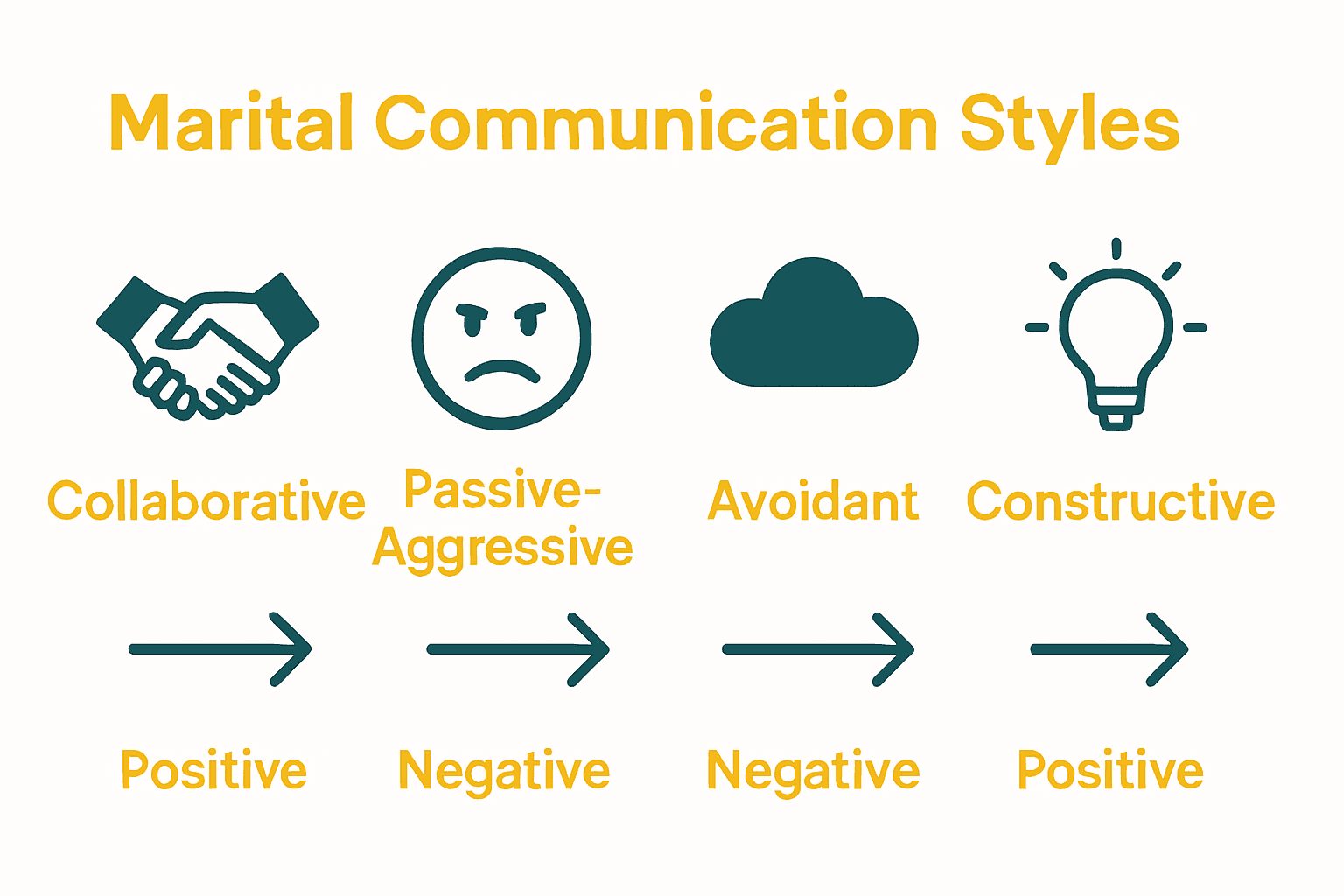Studies show that couples who communicate openly report up to 62 percent greater marital satisfaction compared to those who struggle with conversations. For many wives, learning the right strategies can mean the difference between feeling disconnected and building a deeply supportive partnership. Understanding which communication styles work best—and how to turn everyday dialogue into opportunities for genuine connection—offers a powerful foundation for lasting relationship happiness.
Key Takeaways
| Point | Details |
|---|---|
| Effective Communication | Wives should practice active listening, emotional awareness, and strategic expression to foster deeper connections with their husbands. |
| Recognizing Styles | Understanding various marital communication styles—collaborative, passive-aggressive, avoidant, and constructive—can enhance empathy and connection. |
| Navigating Conflict | Approaching difficult conversations with empathy and active listening transforms conflicts into opportunities for growth and understanding. |
| Avoiding Pitfalls | Developing emotional awareness and practicing collaborative problem-solving can prevent destructive communication patterns that damage relationships. |
Table of Contents
- Defining Communication Strategies For Wives
- Types Of Marital Communication Styles
- Core Principles Of Effective Spousal Dialogue
- Building Emotional Connection Through Talk
- Navigating Conflict And Difficult Conversations
- Avoiding Communication Pitfalls In Marriage
Defining Communication Strategies for Wives
Effective communication is the cornerstone of any healthy marriage, and understanding communication strategies provides wives with powerful tools to create deeper connections with their husbands. Communication isn’t just about talking more – it’s about communicating with intention, clarity, and emotional intelligence. Understanding communication in marriage requires recognizing that each partner brings unique communication styles and emotional needs to the relationship.
At its core, a communication strategy involves three critical elements: active listening, emotional awareness, and strategic expression. Active listening means truly hearing what your partner says without immediately preparing a response. This requires putting aside distractions, maintaining eye contact, and showing genuine interest in understanding your husband’s perspective. Emotional awareness involves recognizing not just the words being spoken, but the underlying feelings and motivations driving those words.
Strategic expression means communicating your own needs and feelings in a way that invites connection rather than creating defensiveness. This includes using “I” statements that express your emotions without blaming, maintaining a calm and respectful tone, and choosing appropriate moments for important conversations. The goal isn’t to win an argument, but to create mutual understanding and solve problems collaboratively.
By developing these communication strategies, wives can transform their relationships from transactional interactions to meaningful, supportive partnerships that grow stronger with each conversation.
Types of Marital Communication Styles
Marital communication styles are complex patterns of interaction that define how couples communicate, resolve conflicts, and maintain emotional connection. According to a groundbreaking study from Pakistan, one prominent communication pattern is the demand-withdrawal dynamic, where wives typically initiate discussions and make requests, while husbands tend to retreat or avoid engagement. Interestingly, this research revealed that even these seemingly challenging communication patterns can be associated with emotional intimacy and marital happiness.
Four primary communication styles emerge in marital relationships: collaborative, passive-aggressive, avoidant, and constructive. The collaborative style represents the most healthy approach, where both partners actively listen, express feelings openly, and work together to solve problems. In contrast, passive-aggressive communication involves indirect expressions of negative emotions, often through sarcasm or subtle emotional manipulation. The importance of communication in marriage cannot be overstated in understanding these complex interactions.
Avoidant communication occurs when partners deliberately avoid discussing sensitive topics, creating emotional distance. This style can lead to unresolved conflicts and gradually erode relationship trust. The constructive communication style represents the ideal, characterized by direct, respectful communication that validates each partner’s feelings while focusing on finding mutual solutions.
Here’s a comparison of the four primary marital communication styles discussed:

| Communication Style | Characteristics | Impact on Relationship |
|---|---|---|
| Collaborative | Open expression Active listening Problem-solving together | Builds trust Strengthens intimacy |
| Passive-Aggressive | Indirect negativity Sarcasm Emotional manipulation | Creates confusion Undermines respect |
| Avoidant | Discussion avoidance Emotional distance Withholding feelings | Leads to unresolved conflict Weakens trust |
| Constructive | Direct & respectful Validates feelings Focus on solutions | Fosters mutual understanding Promotes growth |
Recognizing and understanding these communication styles is crucial.
Couples who can identify their default patterns can consciously work to develop more effective, empathetic communication strategies that strengthen their emotional bond and create a more supportive, understanding relationship.
Core Principles of Effective Spousal Dialogue
Effective spousal dialogue requires a nuanced approach that balances emotional intelligence with structured communication techniques. According to Affiliative Conflict Theory, couples must navigate the delicate balance between intimacy and autonomy, recognizing that successful communication isn’t about winning arguments, but creating mutual understanding. This means learning to express needs while simultaneously respecting your partner’s emotional space and individual perspective.
The concept of fair fighting emerges as a critical principle in marital communication. Understanding active listening in marriage becomes paramount in this context. Fair fighting emphasizes structured, respectful methods of addressing differences, focusing on constructive dialogue rather than hostile, blame-oriented exchanges. Key elements include avoiding personal attacks, using “I” statements to express feelings, and maintaining a collaborative problem-solving mindset.
Critical principles of effective spousal dialogue include active listening, emotional validation, and strategic expression. Active listening means fully concentrating on what your partner says, without preparing a defensive response. Emotional validation involves acknowledging your partner’s feelings, even when you might disagree with their perspective. Strategic expression requires communicating your own needs clearly and compassionately, choosing moments and language that invite connection rather than create distance.
Ultimately, effective spousal dialogue is an ongoing practice of mutual respect, empathy, and intentional communication. It’s about creating a safe emotional environment where both partners feel heard, understood, and valued. By consistently applying these principles, couples can transform potential conflicts into opportunities for deeper connection and mutual growth.

Building Emotional Connection Through Talk
Building emotional connection through conversation requires more than simple dialogue – it demands intentional, nuanced communication that goes beyond surface-level exchanges. Groundbreaking research reveals fascinating insights into how couples create emotional intimacy through talk. A recent study demonstrated that positive communication patterns, even those involving demand and withdrawal dynamics, can surprisingly enhance emotional closeness between partners.
Conversational variety emerges as a critical factor in deepening emotional bonds. Researchers using advanced sentence-embedding analysis discovered that lower semantic similarity in positive conversations correlates with stronger emotional experiences. This means that partners who introduce diverse topics, perspectives, and communication styles actually create more meaningful connections. Understanding emotional intimacy in marriage becomes crucial in implementing these insights effectively.
Key strategies for building emotional connection include practicing vulnerable communication, actively listening without judgment, and creating safe emotional spaces for sharing. This involves discussing not just daily events, but deeper feelings, fears, dreams, and personal reflections. Wives can foster connection by asking open-ended questions that invite meaningful dialogue, sharing their own emotional landscape, and demonstrating genuine curiosity about their partner’s inner world.
Ultimately, emotional connection through talk is an ongoing journey of mutual discovery. It requires patience, empathy, and a commitment to understanding each other beyond words. By approaching conversations with authenticity, compassion, and a genuine desire to connect, couples can transform simple talk into a powerful tool for building lasting intimacy and mutual understanding.
Navigating Conflict and Difficult Conversations
Difficult conversations represent critical moments in marital relationships, demanding exceptional emotional intelligence and strategic communication. According to research, these interactions involve navigating sensitive, emotionally charged topics while maintaining relationship integrity. The complexity lies not just in addressing the immediate issue, but in managing underlying emotional dynamics that can potentially damage the connection between partners.
Advanced conflict resolution approaches, such as the ConflictLens system, leverage sophisticated analytical techniques to help couples understand the deeper mechanisms driving their disagreements. Fighting fair in marriage becomes crucial in transforming potential confrontations into opportunities for mutual understanding. The key is approaching difficult conversations with a strategic mindset that prioritizes empathy, active listening, and collaborative problem-solving over winning an argument.
Practical strategies for navigating challenging discussions include creating a safe emotional environment, using “I” statements to express feelings without blame, and practicing emotional self-regulation. This means managing your own emotional reactions, staying calm under pressure, and maintaining a genuine desire to understand your partner’s perspective. Wives can effectively de-escalate potential conflicts by listening actively, validating their partner’s emotions, and seeking common ground rather than defending their position.
Ultimately, mastering difficult conversations is about transforming conflict from a potential relationship threat into a pathway for deeper connection. It requires patience, vulnerability, and a commitment to mutual growth. By approaching these moments with compassion, curiosity, and a genuine intention to understand, couples can turn challenging interactions into opportunities for strengthening their emotional bond and developing more profound mutual understanding.
Avoiding Communication Pitfalls in Marriage
Marriage communication is a delicate landscape fraught with potential misunderstandings and emotional landmines. The Gottman Cascade Model reveals four critical negative behaviors – criticism, contempt, defensiveness, and withdrawal – that can systematically erode relationship foundations. These destructive communication patterns, often called the “Four Horsemen,” represent significant warning signs that can quickly transform healthy dialogue into relationship-damaging exchanges.
Emotional neglect emerges as another profound communication pitfall that can silently undermine marital connections. Understanding common marriage problems becomes crucial in recognizing how seemingly minor communication breakdowns can progressively damage relationship trust. Research demonstrates that consistently failing to respond to a partner’s emotional needs creates distance, resentment, and ultimately, relationship disconnection.
Practical strategies for avoiding communication pitfalls include developing emotional awareness, practicing active listening, and maintaining a spirit of collaborative problem-solving. This means learning to express feelings without blame, creating safe emotional spaces for vulnerability, and approaching disagreements as shared challenges rather than competitive battles. Wives can interrupt negative communication cycles by recognizing early warning signs, pausing before responding defensively, and consistently choosing empathy and understanding over being right.
Ultimately, avoiding communication pitfalls requires ongoing commitment, self-reflection, and mutual respect. By remaining intentional about how we speak, listen, and respond, couples can transform potential conflict into opportunities for deeper understanding and connection. The most successful marriages are built not on perfect communication, but on a genuine commitment to growing together through compassionate, honest dialogue.
Transform Your Marriage With Communication That Creates Lasting Connection
Struggling to turn everyday conversations into genuine connection with your husband? If you are ready to leave behind misunderstandings and emotional distance, our For Wives resource hub can help you master concepts like active listening, demand-withdrawal dynamics, and fair fighting that you discovered in this guide.

Take the next step and explore practical tools and daily relationship wisdom crafted just for your journey. The insights and solutions at Wise Husband are designed not just for husbands, but for wives seeking open communication and a stronger partnership. Every day is a new chance. Visit For Couples now and start building the marriage you want—one honest, supportive conversation at a time.
Frequently Asked Questions
What are effective communication strategies for wives?
Effective communication strategies for wives include active listening, emotional awareness, and strategic expression. These strategies can help create deeper connections and foster understanding in the relationship.
How can I improve my active listening skills in marriage?
To improve active listening skills, focus on fully concentrating on your partner’s words without planning a rebuttal. Maintain eye contact, ask clarifying questions, and validate their feelings to show genuine interest.
What are the common marital communication styles?
The common marital communication styles include collaborative, passive-aggressive, avoidant, and constructive. Each style has a different impact on the relationship, with collaborative and constructive styles being the most effective for building intimacy and trust.
How can I navigate difficult conversations with my spouse?
Navigating difficult conversations involves creating a safe emotional environment, using ‘I’ statements to express your feelings, and practicing emotional self-regulation. Focus on compassionate listening and finding common ground to enhance understanding.
